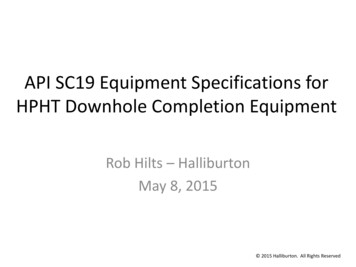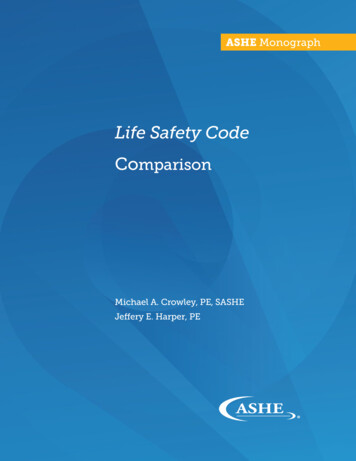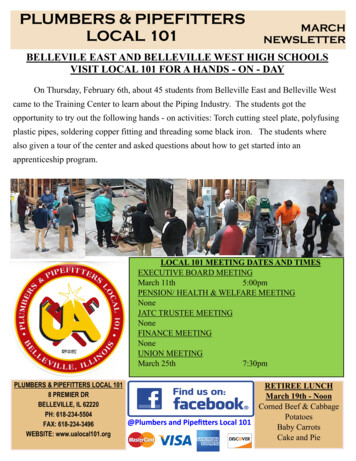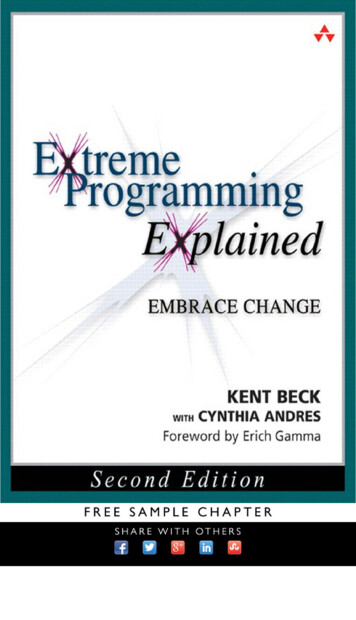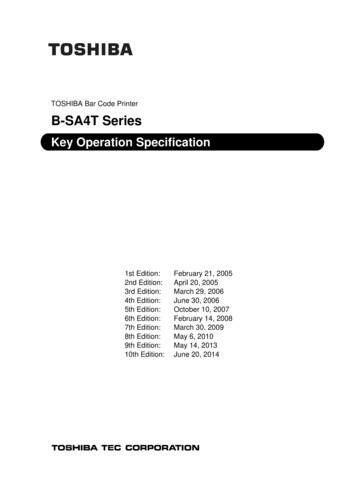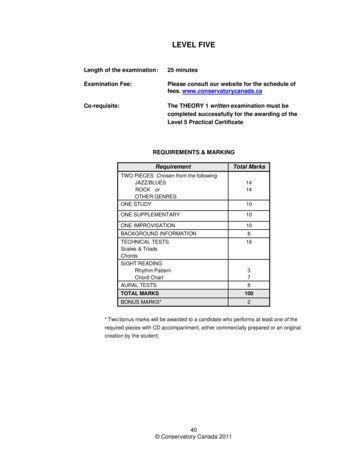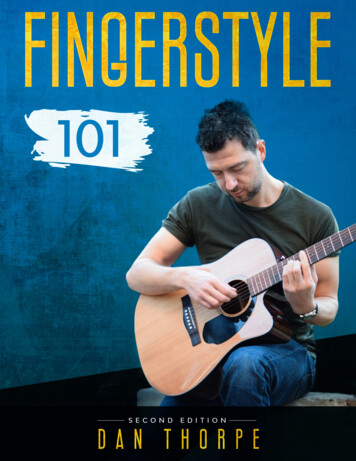
Transcription
Fingerstyle101(Second Edition)A Step By Step Guide to Becoming a Confidentand Skilful Fingerpicking GuitaristDan Thorpe
Copyright 2020All rights reserved. No part of this book may be copied or distributed in any way whatsoeverwithout the prior written permission of the author, Dan Thorpe.First edition published in 2015.DisclaimerAll the material contained in this book is provided for educational and informational purposesonly. No responsibility can be taken for any results or outcomes resulting from the use of thismaterial.While every attempt has been made to provide information that is both accurate andeffective, the author does not assume any responsibility for the accuracy or use/misuse ofthis information.Audio and DownloadsTo download or stream all the audio for this book and get your exclusive printable tab PDF,please go here—rockstarpublishing.co.uk/F101Free ResourcesHead to my blog at guitardomination.net to join my free mailing list and get my best tips,tricks, and freebies sent to your inbox.
Dan Thorpe’s simple and straightforward bookteaches you everything you need to know to beable to fingerpick with great technique andconfidence!Fingerstyle 101 is laid out in a simple step-by-stepmanner, making the material easy to follow soyour fingerpicking journey is an enjoyable one!
Reader reviews for Fingerstyle 101Five Stars“Another fantastic book by Dan Thorpe. The book is well structured and clear. It ‘speaks’to you almost as if Dan is in front of you giving you a lesson. Each chapter flows logicallyinto the next with a good mix of easy to understand theory and practice exercises. Thebuilding blocks soon start to stack up and you get visible results. Can’t get enough of thisauthor’s books—they’re great!”—Anne K.Five Stars“It is definitely a positive force in keeping those of us over 50 to keep on plugging awayand having fun playing the guitar.”—Charles F. McGrother, Jr.Five Stars“I must say that this is a terrific book for anyone interested in this style of guitar playing.It is a bargain and I heartily recommend it.”—Amazon Customer
READER REVIEWSFive Stars“Great little book to get you started on fingerpicking.”—D.H. HobsonFive Stars“Dan Thorpe has my full respect with his humble way of serving a good solid foundationto increase my fingerpicking skills.”—Allan SchrattenholzFive Stars“I like Dan Thorpe; he is very refreshing as a guitar tutor. I’ve tried many books previouslyand don’t usually get to finish them. If you want to get into fingerstyle or want to improve,then this is a great guide to give you some material to work with.He comes across as someone who actually wants you to succeed and this is really motivating to make you pick up the guitar each day and practise to improve.”—John Philcox
Table of ContentsINTRODUCTION 1PART I: THE ABSOLUTE FUNDAMENTALS OF FINGERPICKING 4The Secrets of Fingerpicking Technique that Most Guitarists Get Wrong 8Pro Tips to Make Your Fingerpicking Journey Easier and More Enjoyable 22Rhythm 101 and the Key to Making Great Music 32The 7 Most Deadly Fingerpicking Mistakes 36Part I: Summary 39PART II: THE 10 FUN, STUNNING, AND MUST KNOW FINGERPICKINGPATTERNS 40#1 The “Going Up” Pattern 42#2 The “Outwards” Pattern 47#3 The “Ballad” Pattern 52#4 The “Ultra-Flexible” Pattern 57#5 The “Outside-In” Pattern 62#6 The “Romanza” Pattern 68#7 The “London” Pattern 73#8 The “Cascading” Pattern 78#9 The “Butler” Pattern 84#10 The “Sweet Melody” Pattern 90Part II: Summary 95
TABLE OF CONTENTSPART III: DEVELOPING FURTHER AND AN EXPERIENCED GUITARTEACHER’S WORDS OF WISDOM 96The 10 Steps for Getting the Most Out of Your Fingerpicking Playing 97Part III: Summary 110THE END. AND IMPORTANT WORDS OF ADVICE 111APPENDIX I: CHORD REFERENCE GUIDE 114APPENDIX II: A BEGINNER’S GUIDE TO READING GUITAR “TAB” 120ACKNOWLEDGEMENTS, LINKS AND OTHER USEFUL RESOURCES 128ABOUT THE AUTHOR 130
INTRODUCTIONThe guitar is a wonderful, complex, and intricate instrument that can do so manythings. To me, however, it sounds at its best when stripped back to its pure, raw, andhonest sound—this is as good as music gets.There aren’t many better sounds in the world than a guitar being fingerpicked. Whenplayed well, fingerpicking guitar is truly wonderful and it is a way we can bare our soulsand express ourselves giving us so much joy, liberation, and fun.These feelings of fun are what I want for you too, and I truly believe you can get them.In fact, from my vast experience of teaching fingerpicking to others, I know that withsome focused practice, you can achieve this too!Who is the book for?This is a beginner book on fingerpicking and one that is aimed to take you from theabsolute basics to an early intermediate level.Most of my students and many of you reading this are learning a little later on in life,and if you are, this book is written for you (although the material will work for everyoneelse too).I say this because most guitarists who are 50 have had years of frustration trying to playthe music they love to a high standard. That is why I wrote this book—to help you solvethese issues in an enjoyable manner.1
DAN THORPE: FINGERSTYLE 101A new edition for a new beginningThis is the second edition of Fingerstyle 101 and while the first edition was very wellreceived and got dozens of great reviews, it was not the complete article. Now it is, and ithas been added to in many ways, making it a much more complete book than before.The book is broken up into the following three parts.Part I is the essential appetizer that is all about the fundamentals, playing with good technique and setting your fingerpicking playing up to be successful, not just now, but for therest of your playing days.Part II is the main course where you will learn the ten most exciting fingerpickingpatterns over three examples, which start off steadily and then get progressively harder ina systematic way (making them easier to learn).Part III is the dessert where you will discover some important methods that will help youto learn faster, practise more efficiently, remember more, and even help to keep yourbrain age younger!You can read the book in order or you can “hop about” as some people prefer to do. Thebook is designed to aid you at every step—just be careful not to try to learn too manypatterns, ideas, or exercises in one go.If you have struggled before, think of this book as a fresh startIf your playing has been frustrating, do NOT worry, we will fix it! It will take somepatience and perseverance, but if you commit 20 minutes a day to practising the materialin this book for at least five days per week, and do so with total focus, you will make greatprogress!My methods of teaching fingerpicking guitar are a hybrid of the classical and the modernmethods. These methods will teach you to play with solid technique while you have funlearning the styles of music that are popular amongst my students (such as 60s folk, pop,and other acoustic styles).2
INTRODUCTIONI teach with a big focus on my “T.E.S.T.” method of learning guitar. The “T.E.S.T.” methodstands for: Technique Enjoyment Specific Plans Time ManagementThe above four factors are what, in my opinion, make the difference between a poorguitarist and one who reaches his or her potential. The best guitarists around, no matterwhat their age, skill level, or background, optimise all four of the above. Of course, you donot have to get each of the above areas perfect but improving these four areas will helpyour playing in both the short and long term.After optimising the above, the next thing to do is to actually “test” yourself on yourplaying. I’ll show you how to do this and optimise each of the four areas above as we gothrough the book.The book has been inspired by so many of the greats of fingerpicking guitar—players suchas Paul Simon, James Taylor, Ralph McTell, Ferdinando Carulli, Tommy Emmanuel, andso many more.Are you ready for an exciting journey?If so, let’s begin.3
PART I:THE ABSOLUTE FUNDAMENTALSOF FINGERPICKINGIn this section, we are going to cover many of the basics of fingerpicking which will beimportant on your journey.These basics include learning and fixing the most common fingerpicking mistakes,discovering the essentials of fingerpicking technique, learning the basics of rhythm, andmore.If you feel you are already solid with the basics of fingerpicking, then feel free to jumpahead to Part II where we will cover the 10 exciting fingerpicking patterns. If you dojump ahead though, I recommend you come back and go over this section anyway, aseven one or two tips here can save you a lot of time.A word from Plato.Before we get into the super practical stuff, I want to share this great quote with you. It’sattributed to Plato, the ancient Greek philosopher.“Music gives a soul to the universe, wings to the mind, flight to the imagination and lifeto everything.”What a wonderful quote—he was right, and back then he didn’t even have The BeachBoys to listen to!All jokes aside, it’s a good idea to remember this Plato quote when the going gets tough atany point in your playing. It has inspired me and many of my students over the years.4
PART I: THE ABSOLUTE FUNDAMENTALS OF FINGERPICKINGThe Fundamentals You Need to Know.Let’s have a quick primer on the fundamentals as this will help you to avoid any confusionwhen working through the book. Some of this may seem basic but in fact, many beginnersdon’t know or are unsure about these things.The string namesThroughout the book, the six strings of the guitar will be described as their open stringnotes and NOT their string number. For example, we call the: 6th string, the low E string (the thickest string) 1st string, the high E string (the thinnest string)The “Bass and Treble” stringsIn the book, to help explain the different sounds you can get from striking differentstrings, I sometimes refer to the “Bass” strings or the “Treble” strings: Bass strings: Low E, A, and D strings Treble strings: G, B, and high E stringsThe “rules” of fingerpickingYou may well already know this, but it is worth reminding you. Most of the time, whenfingerpicking, the: Thumb plays the bass strings (low E, A, and D)Index finger plays the G stringMiddle finger plays the B stringRing finger plays the high E string5
DAN THORPE: FINGERSTYLE 101As you will see later on, there are exceptions to the “rules” and there are some importanttechnical tips which we will cover in the next section.The audioTo make the examples easier to learn, each track has two audio versions—one played at anormal speed and one played at a slowed down speed.You can get the audio (available to stream or download) for every example in the book atthe link below.rockstarpublishing.co.uk/F101The book and the audio tracks are broken up into three parts, so make sure you use thecorrect audio tracks for the relevant part of the book. Each audio is given a BPM (Beats Per Minute)—which is the tempo of the piecewhen played at full speed. You do not have to play it at this speed—that is just anindicator of the tempo I played it at. When playing with the audio, listen closely to it so you get the rhythm and the detailscorrect. Try to play along with the slowed-down versions before you attempt the fasterversion. For all the audio examples there is a “count-in” lasting the same length as the timesignature (e.g. for 4/4 time, there will be four intro beats to count you in). If you areunsure about them, fear not, we will discuss time signatures more later. Slowing things down can make learning the examples easier but you will have toreally concentrate on keeping things slow and not let yourself speed up. This goesfor when practising with and without the audio.6
PART I: THE ABSOLUTE FUNDAMENTALS OF FINGERPICKINGThe capo is a guitarist’s best friendIn the book, some of the examples use a capo and some do not. The main reason for using a capo is that many beginners find it easier to play higher up the fretboard as they are required to stretch less. (To clarify, “higher up”means the higher frets closer to the bridge of the guitar—e.g. fret 8 is higher thanfret 5). Using a capo at different frets also changes the tone and pitch of the guitar whichkeeps things fresh and exciting from a musical point of view. You can, of course, play the examples with the capo anywhere you like, or even nocapo at all. Just be aware that when playing along with the audio examples, you willneed to place the capo where instructed to be in the correct key, or playing along withme will sound bad!TablatureMost guitarists I teach already know how to read tablature or “tab” for short. Some can readstandard notation instead of, or alongside, tab but as reading tab is needed as a minimumfor you to be able to use this book, I have created a guide to this. You can find this guide in Appendix II. This guide is in the appendix as most of you will already be comfortable with readingtab, but if not, or you need a refresher, check out this section before continuing.7
DAN THORPE: FINGERSTYLE 101The Secrets of Fingerpicking Techniquethat Most Guitarists Get WrongTechnique is so important, yet most guitarists never really learn how to play guitar in arelaxed manner with zero pain or discomfort. Instead, their playing is often frustratingand painful, and progress is usually slow.Worst of all, the music will also sound poor. If your dog or cat runs away when you play,poor musicality, which stems from bad technique, is usually the reason why. If this is thecase for you, don’t worry, we will fix this and get your little friend bopping along in no time!In the “T.E.S.T.” method of learning guitar, the first “T” stands for “Technique”—it is thefirst letter for a good reason! After teaching well over one hundred beginners and teachingthousands of hours of lessons to a wide variety of students, I know that basic technique isparamount or students will struggle much more than they should.To make big improvements to your technique, study the following tips and apply them toeverything in the book, and everything else you play too.Now, the playing will begin, so you will want to get the audio tracks. Remember, whenlistening to the audio, we are in Part I of the book, so ensure you listen to the correct file.Get the audio from the link below:rockstarpublishing.co.uk/F101Train One Hand at a TimeThis method of practice is one of the big things I talk about with students and it is this:When learning anything new, focus on working on each hand in isolation for at least abrief period.8
PART I: THE ABSOLUTE FUNDAMENTALS OF FINGERPICKINGWorking on both hands at the same time when learning something new is a recipe forbrain overload!Fingerpicking is complex, so take it steady and try to do the following:1. Run through the part played with the picking hand only—play the pattern on eitherjust one chord or on the open strings.2. Run through the chord changes with the fretting hand without plucking any notes—therefore in silence.3. When you feel more confident, put it all together, but don’t be afraid to take a stepback and work on each hand separately.The above concept of working on each hand in isolation is a powerful one and it shouldbe used throughout the book, and also for anything else you learn on guitar. Training onehand at a time prevents brain overload, makes it easier to learn each part, and definitelymakes the learning process smoother and more efficient.The “Classical with a Strap” PositionI believe all guitarists should use the “Classical with a strap” (or “CWAS” for short)position to sit in when playing guitar. The CWAS position takes a lot of strain off the wrist, it allows you to move up,down, and across the fretboard more easily, and it encourages you to sit with a niceupright posture, taking the strain off your back. It also more closely replicates a natural standing position than when choosing otherways to sit with the guitar. When in the CWAS position, your picking hand will be at a better angle to pluck thestrings, which will help you get a clearer tone rather than the sometimes “scratchy”sound that many get when sitting in the more common and flatter non-classicalposition.9
DAN THORPE: FINGERSTYLE 101Take a look at the images below to see this position in action.10
PART I: THE ABSOLUTE FUNDAMENTALS OF FINGERPICKINGUse the following pointers as a guide in relation to the images (these are based on aright-handed guitarist, so simply reverse the instructions if you are left-handed).1. Raise your left leg on a footstool or use a cushion support to rest the guitar onyour left leg.2. Ensure the curved base of the body of the guitar is on the left leg NOT on theright as done in the more common, flatter position.3. Angle the neck of the guitar so it is pointing upwards at a roughly 45-degree angle.4. Make sure the headstock is above shoulder level at least.5. Keep your back straight and make sure you are NOT hunched over.6. Secure the guitar with a strap—this stops you from having to hold the weight ofthe guitar, meaning if you let go, the guitar stays stable.7. Place the bottom of the guitar’s body so it is as close to your body as you can getit —this ensures the guitar stays flat and is not angled outwards.Out of all of the above pointers, the one most guitarists get wrong is that they let theheadstock of the guitar get too low. It is really important to make sure the headstock ishigh and at least at shoulder level—if not higher. If you have played for a long time, andhave played using other positions, adjusting to this playing position may be a struggle. Ifso, take your time adapting, but I urge you to give it a try.Footstool or leg support?You will need either a footstool to raise your left leg or a guitar leg support instead. Legsupports come in all shapes and sizes and they are in many ways better than a footstool asthey still raise the guitar (to the approximate 45-degree angle needed). They do this whileallowing you to keep your foot flat on the floor, meaning your knee will be placed underlittle or no strain. This is helpful if you have joint issues. There are a lot of inexpensivechoices out there for which footstool or guitar support to use (such as the Ergoplay andmany more), most of which are well worth the investment.11
DAN THORPE: FINGERSTYLE 101The “Cup” PositionBefore you start fingerpicking, I recommend you get into the “Cup” position. The“Cup” is a starting position for where to place your picking hand on the strings.Regularly getting into this position each time you fingerpick will help you to pluck thecorrect strings without errors and without needing to constantly look at the picking hand.To get into the “Cup” position, comfortably rest the following digits on the followingstrings. Thumb—Low E stringIndex—G stringMiddle—B stringRing—high E string12
PART I: THE ABSOLUTE FUNDAMENTALS OF FINGERPICKING It is important to ensure there is a “V” shape between the thumb and index fingeras seen in the close-up. The “V” will help you to make sure the thumb is further up the string (closer to theneck of the guitar) than the fingers. This helps to keep the fingers and thumb out ofeach other’s way when picking. Start off in the “Cup” position for each fingerpicking piece you play and then returnto it regularly if you make a mistake (such as plucking the wrong string) and feel theneed to start again.Here is a simple example to practise which will help you to learn the “Cup” position:Tracks #1-2Capo 5—100 bpmTo play the above piece, pluck the bass note with the thumb and then “pinch” (meaningpluck multiple strings at the same time) the G, B, and high E strings with the index, middle,and ring fingers.Try the above exercise over and over on just one chord at first and do so repeatedly so itsounds good.13
DAN THORPE: FINGERSTYLE 101Then add the chord changes in to play this sweet-sounding piece.Finally, to get used to where the strings are, try playing the piece without looking at thepicking hand at all.What about the fingerpicking hand’s pinkie?In terms of the pinkie finger of the fingerpicking hand, it rarely gets used. I opt to keep itrelaxed and let it “travel” alongside the ring finger when picking—but there are no ruleshere.Just try to avoid keeping the picking hand pinkie sticking out and ramrod straight as itis uncomfortable, it will restrict the fluidity of the other fingers, and it will look like youare ready to drink tea with the Queen!The “Fingerpicking Tone Test”(For a Bright and Punchy Tone)A really simple way to get a better fingerpicking tone is to do what I call the “Fingerpicking tone test”.This is where we use a pick to help improve our fingerpicking tone.“How?” you may wonder.Well, your fingers probably vary in how strong or nimble they are which can lead toimbalances in the way the strings are picked and therefore, the tone produced. Incontrast, a pick usually gives us a consistently bright and clear sound without mucheffort—so let’s put a pick to good use!Take a look at the tab and then follow the instructions on how to perform the “tone test”.14
PART I: THE ABSOLUTE FUNDAMENTALS OF FINGERPICKINGTracks #3-4Capo 5—100 bpm Play the pattern with your fingers as you would normally. Now, play the pattern with a pick and notice how clear and crisp it sounds. Once again, play the pattern with your fingers, but this time, when you play it withyour fingers, try to mimic the sound, tone, and volume of a pick.Now, this only works if you get a decent tone with your pick when using one (but 99% ofguitarists do). It also takes a little practice, but by aiming to replicate the sound a pickmakes, your tone will become more rounded, brighter, and clearer.Your fingers will never sound exactly like a pick, but this exercise is there to make youaware that if you are like most guitarists, you can probably add so much more life toyour fingerpicking tone.Try this little exercise each time you pick up the guitar.15
DAN THORPE: FINGERSTYLE 101“Minimum Pressure Required”Even though this book is about fingerpicking, it is essential that your fretting hand hasefficient technique and this simple concept can fix what is probably the most counterproductive issue that plagues most guitarists.Nearly every student I have ever taught presses too hard and this causes pain and discomfort, tired fingers, excessive calluses, possible injuries, and can basically kick the fun out ofyour playing!“Minimum pressure required” is an exercise that I show every student (no matter howlong they have played) on their first lesson with me and it is one that will go a long way tofixing these issues. Play the 5th fret on the high E string with your index finger—get it as close to thefret as possible and then pluck this string. Keep adding and removing pressure until you find the point where the note is stillclear but you are pressing as lightly as possible. This is your “sweet spot”—remember how little pressure you need to make thenote clear! Repeat with each finger on the 1st, 5th, and 10th fret of all six strings.Now apply the above ideas to the following E natural minor scale. We are playing twooctaves of the scale, first going up the scale and then coming back down the scale. Youmay notice I have notated the open E string twice. Some guitarists find it easier to pluckthe top note in a scale twice as it acts as a “reset” point for coming back down the scale.Remember, it is all about playing the notes so they sound clear while you play them withthe lightest touch possible.16
PART I: THE ABSOLUTE FUNDAMENTALS OF FINGERPICKINGTracks #5-6No capo—50 bpmHmm, aren’t scales boring?Scales don’t have to be boring. Scales, in fact, make for a great warm-up and, when doneproperly, are a great technique builder, and that’s before you even use them in your playing. Remember to go slowly and really concentrate on pressing as lightly as you canwith the fretting hand fingers. Try to use one finger per fret with the fretting hand so you are not jumping aboutfrom fret to fret with the same finger. In terms of picking the scale, the simplest method is to pick it using alternatingindex and middle fingers.If pressing harder than you should is a habit of yours, it will take some practice using the“Minimum pressure required” method of playing. Keep reminding yourself of just howlittle pressure is needed to fret a note by doing this exercise regularly!17
DAN THORPE: FINGERSTYLE 101Ensure You Use Precise Fretting Hand TechniqueIt is essential that you always use goodgeneral fretting hand technique whenplaying or you will find that your fingerswork against you and not for you.Here is what is happening in the image tothe right and what you should aim for withyour fretting hand: Each finger should be separated from the base (where the finger meets the hand)and NOT just at the tip. Finger position—middle and ring fingers should be fairly straight; the index andpinkie should point a little more outwards. The “distal joint” (the last digit in each finger—nearest the nail) should be curled. Each finger should be very relaxed and free from all tension—try to occasionallylift a finger off the fretboard and gently “wiggle” it around to relax it. When you take a finger off the fretboard, make sure it doesn’t “fly out” awayfrom the strings. In other words, keep your non-playing fingers (those off the fretboard) as close to the fretboard as possible when they are not in use.Now then, keep the above in mind and try the following exercise.Tracks #7-8No capo—100 bpm18
PART I: THE ABSOLUTE FUNDAMENTALS OF FINGERPICKINGThis is a slightly “scalic” exercise that has a few stretches across the high E string. Thereare no rules for which finger frets which notes, but I recommend you use your indexfinger for the 1st fret and pinkie for the 5th and 7th frets. Make sure you focus on using thetechnical tips mentioned and go slowly with it.Remember, if you have struggled before, you are undoing bad habits, so it will take time.It is well worth the effort though, as each of the previous points will make your ability tofingerpick both smoother and more enjoyable!Keep Your Body RelaxedMany guitarists have a completely tense body when they play. It is difficult to relax thefingers and hands and get them moving how you want them to if you are so tense thatyour shoulders are hunched, your stomach is in knots, and you are grinding yourteeth!To avoid this, try these tips. Mentally “scan” your whole body up and down to check for any signs of tensionin your muscles and parts of your body such as your stomach, upper arm, jaw, andshoulders. Breathe slowly and deeply from your diaphragm to ensure you fully relax yourbody from head to toe. Stop playing every now and then to check you haven’t started holding your breathand you haven’t tensed back up.Follow this advice on all the musical examples throughout the book and incorporate thesetips into your daily playing. Do be aware though that, as fingerpicking takes a lot ofconcentration, it can be easy to slip back into old habits.19
DAN THORPE: FINGERSTYLE 101Aim to stay relaxed when you practise and you will make more progress and enjoy yourplaying more for it. Just don’t be so relaxed that your jaw gets slack and a bit of salivadrops out—this actually happened to a student of mine during a lesson!All of the above is solid, basic, and very fundamental advice that I get all my studentsto follow. I urge you strongly to grasp and apply all of these technical tips as much asyou can and keep coming back to them on a regular basis.The above covers the “T” for “Technique” in the “T.E.S.T.” method but as it is essential, Iwill be reminding you of some of these ideas throughout the book.The Fingerpicking with the “Nails or Skin” DebateThere is an age-old debate about whether or not you should use your nails orthe skin of your fingers to fingerpick with.Many legendary guitarists and classical teachers have been split over this forhundreds of years. Instead of me telling you what to do, I want to give you someuseful pointers based on my playing and teaching experience.If you use your nails: You will find it easier to get a brighter sound—this is because nails naturally sound brighter than the skin of your fingers. Your tone can be a little scratchy when using your nails so you mustensure your technique is tidy and you pluck across the string and not downit (the “CWAS” position will help here). Remember, nails can break and it requires careful attention to keep themat a consistent length.20
PART I: THE ABSOLUTE FUNDAMENTALS OF FINGERPICKINGIf you use the skin of your fingers to pick with, be aware: Skin can be harder to get a good, bright tone with—this is because skindoesn’t create a sharp attack on the strings like nails do. Over time, you can improve your tone by trying to build up calluses onthe ends of your fingertips which is the method some of the greats,including Tommy Emmanuel, use. To get good tone with the skin of your fingers, you will need to learn howto pluck with more force and fluidity.Many past master classical teachers
Five Stars “Great little book to get you started on fingerpicking.” —D.H. Hobson Five Stars “Dan Thorpe has my full respect with his humble way of serving a good solid foundation to increase my fingerpicking skills.” —Allan Schrattenholz Five Stars

